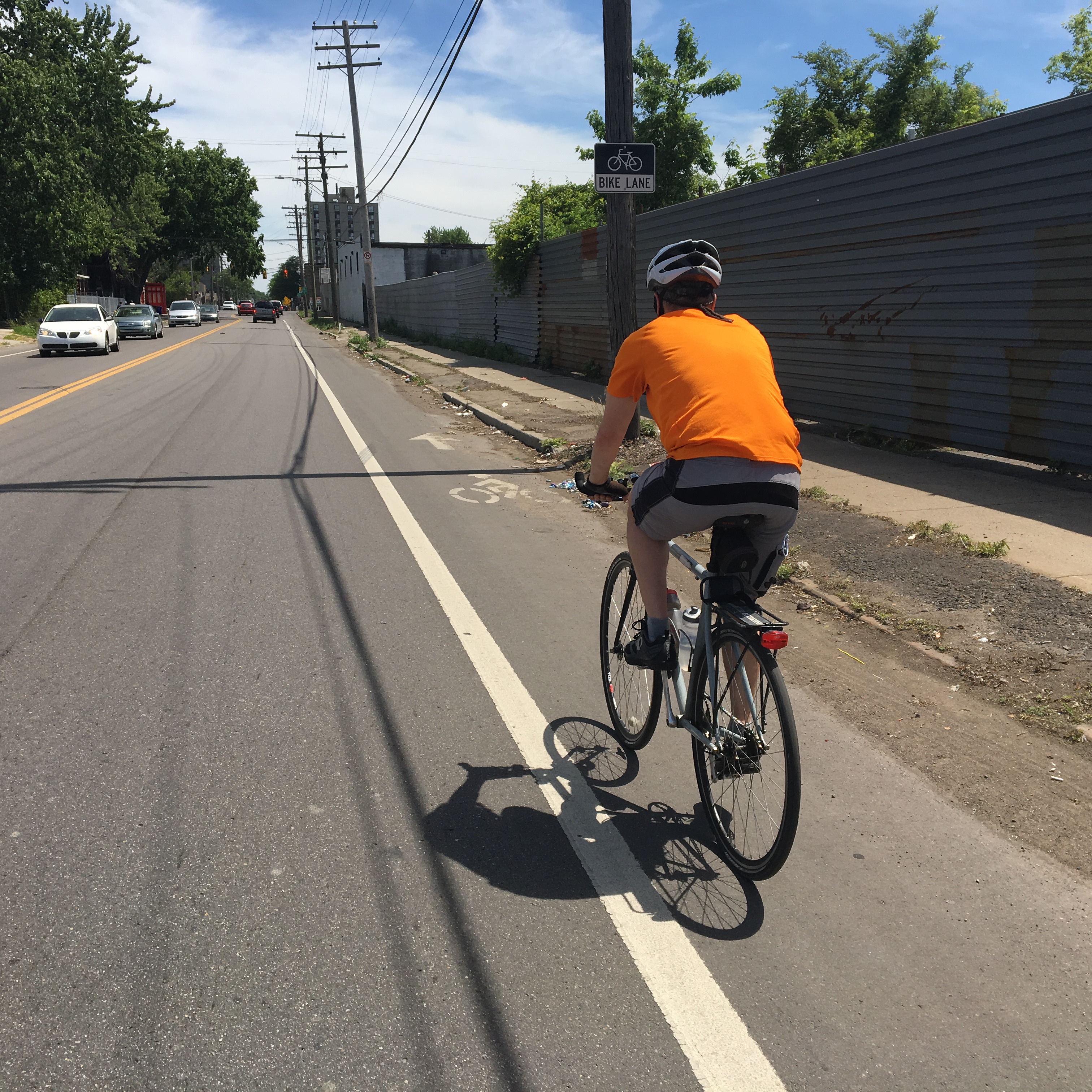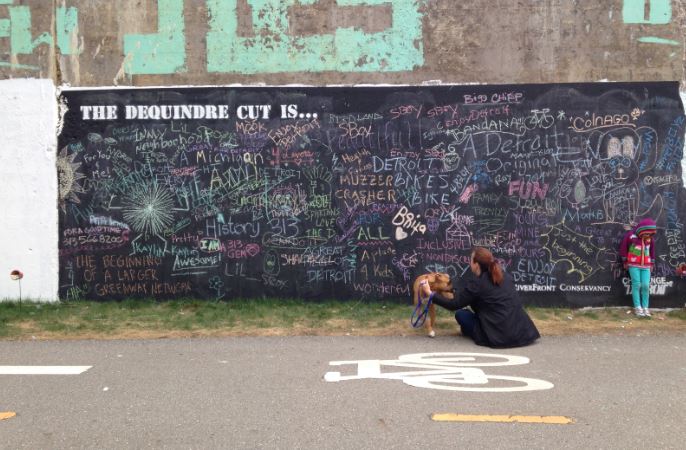Going Motorless in the Motor City
Where can you ride in Detroit? Learn about some of the bicycle-friendly projects.

A decade ago, Detroit had no bike lanes. This year, the count of marked miles for cyclists could reach 200. WDET’s Sandra Svoboda joined Detroit Today Host Stephen Henderson to talk about what it’s like to bicycle in Detroit and where people can ride. Click on the audio link above to hear their full conversation.

How the bike lanes got dreamed up, designed, approved, painted and protected is the work of citizens, community advocates, bicyclists, city officials and engineers. WDET talked with some of them about completed projects and what could be next. “There’s a lot of stuff on the drawing board,” says Mike Darga, senior project engineer at Giffels Webster engineering firm Detroit.

In southwest Detroit, the city’s first few miles of bike lanes have expanded to a network of connected pathways as roads were maintained or improved, says Theresa Zajac, vice president at the Southwest Detroit Business Association.
“The city of Detroit began looking at bike lanes as the asset that they are and can be, and so as they renovate different roads throughout the city of Detroit, including southwest Detroit, they’ve added bike lanes,” she says.

On the east side, the Conner Creek Greenway effort continues. But it’s not just for recreational riders. With about a quarter of Detroit households having no access to a car, according to U.S. Census data, having a route to ride may mean being able to get to a job or school.
“Most of the people I would say that we deal with are using bikes more so for transportation,” says Alex Allen, president and CEO of the Chandler Park Conservancy. “They’re trying to get to the store or trying to get to work or trying to get someplace. We have some recreational riders but they’re mostly riding their bike because they’ve got to get somewhere or they’ve got to get someplace.”
Like other improvements in Detroit, biking and walking projects haven’t reached all neighborhoods. In the northwest corner of the city, the Grandmont Rosedale neighborhood has zero bike lanes, says Tom Goddeeris, executive director of the Grandmont Rosedale Development Corp.
“In our community we have these beautiful residential communities with gorgeous homes, tree-lined streets that are attracting new residents and the demand for houses in our neighborhood is growing,” he says. “But the commercial main street of our neighborhood, Grand River, doesn’t really have that same character or quality.”
Goddeeris would like to see traffic islands and better signals so pedestrians and cyclists could more easily cross Grand River as well as more landscaping and street furniture in the commercial district. He says he’s not alone. More than 100 people have attended recent community meetings to help design improvements for the area.
“The next step is really to get the various public agencies that are responsible for the roadways and the sidewalks including the city and in our case MDOT because Grand River is a state highway, to get them to agree and buy into that same vision,” Goddeeris says. “And then talk about what kind of practical steps can be taken to begin to implement this and what kind of resources it will take.”
Below you can explore comments from Allen, Darga, Goddeeris and Zajac about some of the projects on the above map.
Inner Circle Greenway

“That is a rail-to-trail-type conversion for the most part that will basically get you from the Dequindre Cut area into north of Highland Park and Hamtramck and then circle around back toward the southwest side of the city. … Property acquisition is generally complete. The city is still working on a few more pieces and they’re starting design now. …It will be a whole different about 26 miles of off-road travel and it will connect a whole lot of neighborhoods and give a whole lot of areas where people can connect into that, kind of like the Dequindre Cut. It will be very safe for families and less experienced cyclists.” — Mike Darga, senior project engineer at Giffels Webster engineering firm in Detroit.
WDET’s Sandra Svoboda and Todd Scott, executive director of the Detroit Greenways Coalition explored the route and describe it here.
Second and Third Avenues in Midtown/The Cass Corridor
“Those were very different changes in traffic operation. When the city was booming with cars, a lot of roads got converted to one-way traffic. Now we’re putting them back to two-way conversion. It makes it easier to get into the neighborhoods and then when we converted we also added bike lanes on both roads. It totally changed how people in Midtown up to New Center and across Wayne State can get to either jobs or schools.” — Mike Darga, senior project engineer at Giffels Webster engineering firm in Detroit.
East Jefferson Protected Bike Lanes

“Those are some of the newest facilities in the city. Those just got built in fall of 2015. It was a total change where we actually moved the parking from being along the curb to out along traffic. It creates a protected space where the cyclist doesn’t have to be right adjacent to moving cars. It’s kind of going to be the model and the template for a lot of the new facilities in the city. … It was totally studied with traffic beforehand, so we left plenty of lanes. There’s still two-lanes in each direction for traffic. We made sure we could accommodate all the turns. It’s different, something people have to get used to, seeing the parked cars along the road. … No impact on traffic from what we’ve heard right now. I think people are getting real comfortable on them. Parking is moved from being against the curb to about seven or eight feet out from the curb. There’s just a paint stripe and then there’s these plastic delineators. It’s just basically a plastic post just to kind of reinforce the parking versus the bike lanes. It gives people a more comfortable safer place to bike in.” — Mike Darga, senior project engineer at Giffels Webster engineering firm in Detroit.
Southwest Detroit

“We are looking to have at least up to 40 bike racks installed on Vernor and prior to that as part of the project before that I spoke of, …I think we have 38 bike racks out there already. That spread all the way from here in the Vernor Springwells area of the business district through Corktown and up to Martin Luther King Boulevard. We sort of looked at where it would make more sense where people would want to park their bikes. Maybe it’s a grocery store, maybe it’s outside a church or playground.” — Theresa Zajac, vice president at the Southwest Detroit Business Association.
East Riverfront

“The city’s had something called the East Riverfront Study which is kind of covering the area between Belle Isle and the Central Business District. That’s looking from Larned to the riverfront. It’s looking at what the area should be for development and what it should be for transportation. That will be connecting the lower east side with downtown.” — Mike Darga, senior project engineer at Giffels Webster engineering firm in Detroit.
Conner Creek Greenway

“If you’re doing recreational riding, the Conner Creek Greenway is good. It starts at Maheras Gentry Park and comes up Conner, kind of goes over to St. Jean, you pass a few kind of historical sites along the way, it comes up to Shoemaker, adjacent to Chandler Park, behind Wayne County Community College, to Conner playfield, past the airport. The path takes you … all the way up to Outer Drive.” — Alex Allen, president and CEO of the Chandler Park Conservancy.
Grandmont Rosedale

“We think that we need to make a more pedestrian-oriented atmosphere, and that includes not only making it a more pleasant place to walk but also adding bike lanes and accommodating the future improvements in public transit and that really we need to create the sort of Complete Street environment that will encourage more people to come and stay and shop in our neighborhood.” — Tom Goddeeris, executive director of the Grandmont Rosedale Development Corp.
Dequindre Cut

Emily Rogers, is a 67-year-old Detroiter who rides her bike a lot. “I like the idea of being able to ride freely down the Dequindre Cut. Again, no traffic except for the security guard, but it’s pretty because there are plants on each side. There’s art now, and the art is even more controlled now and it’s really pretty,” she says.
